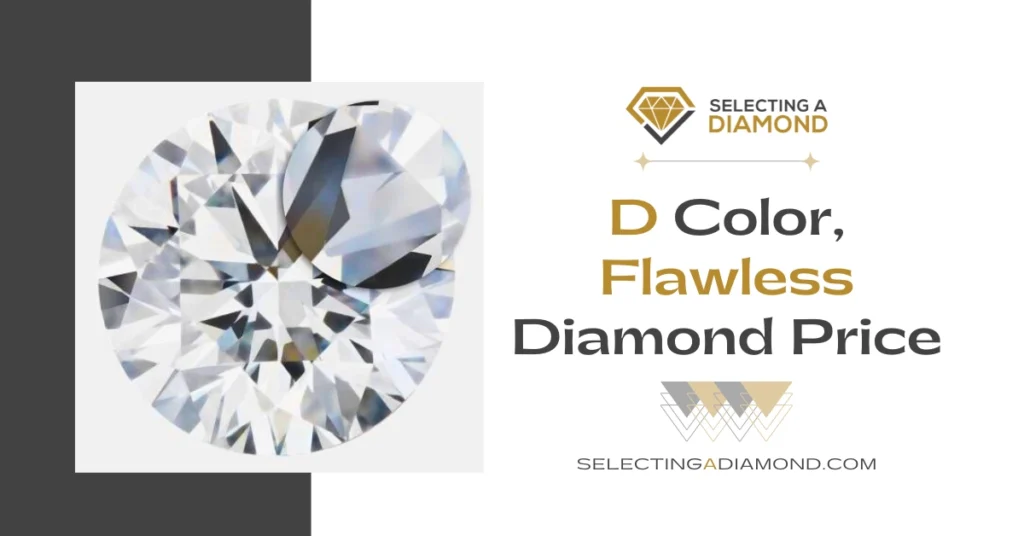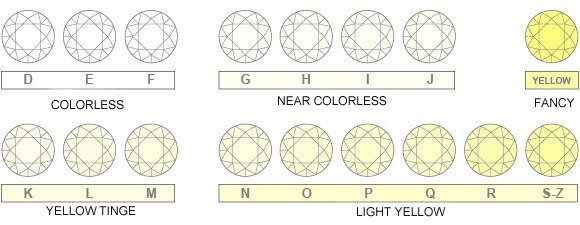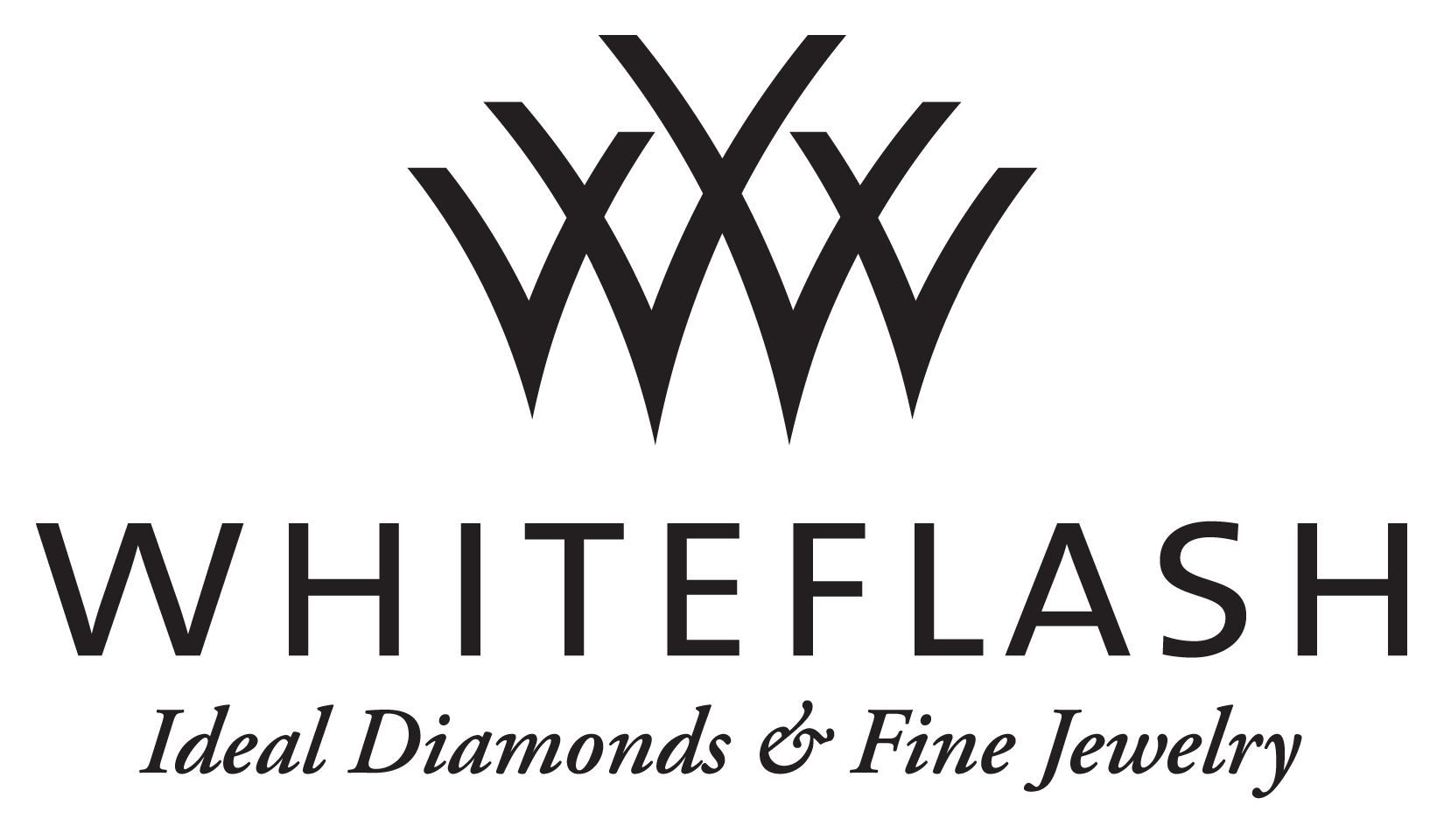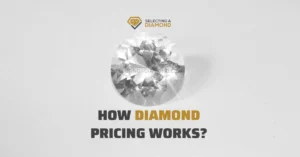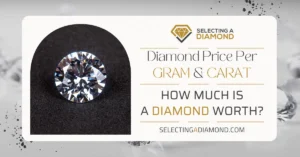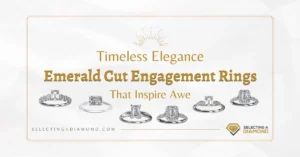If you’re someone with deep pockets, then by all means, why not treat yourself to a 1 carat D flawless diamond, like this stunning piece on James Allen? Shelling out $16,500 might not seem like a big deal.
But for those on a quest to get the most sparkle for their spend, this blog post is your treasure map. We’re going to dive into the eye-watering prices of a D flawless diamond and then guide you on how to select a more magnificent diamond without burning a hole in your wallet.
Let’s kick things off by examining why splurging on this level of luxury might not always be the smartest move. We’ll strip back the layers to reveal the true cost of these gemstones and the actual value they bring to the table.
Keep in mind, we’re discussing the two highest grades here:
Colorless (D grade) and blemish-free (flawless) stones.
To put this in perspective, let’s take a quick look at where these grades fall…
Where D Color Grade Stands?
D color grade diamonds are at the top of the color grading scale for diamonds and are extremely rare, this grade signifies a diamond that is absolutely colorless, and it represents less than 1% of all diamonds mined
The color grading scale created by GIA grades diamonds by letter, and D is the first grade (being the most colorless) to Z (all color grades after K start to show some yellow).
Since only 1% of global diamonds make it to the D color grade, it’s obvious that we’re talking about an extreme high price tag for these diamonds.
Generally, and in order not to spend money on something you can’t see, we recommend our readers to get a G color (sometimes even an H grade).
In short, these two grades will not show any yellow color to the naked eye, but if you want more details, we encourage you to go over H vs. G color Comparison post.
Pro Tip: Even gemologists can NEVER tell the difference between D & E grades by just looking at one of them alone, they have to hold them side by side to tell a difference without any guessing! So don’t ever expect someone to tell what color is your diamond by just looking.
Having that said, it’s obvious that the D color is way too high from the recommendation you will hear from any expert, you’re talking about 3 grades higher from a color that is guaranteed 100% to appear completely colorless.
To shed some light on price difference we’re talking about, the average cost of 1 carat diamond (VS2) with G or H color grade is around $4500-$5000 like this one, but if you jump into a D grade, expect to see diamonds around $6700!
So, only for the color grade, you’re paying around $2000, same will apply to clarity as we will see shortly, and you know what’s more rare?
Having both in a single diamond!
Well, D grade is really fascinating and all, but we don’t recommend it AT ALL.
Where Flawless Clarity Grade Stands?
Diamonds are created under tremendous amounts of pressure and heat. Under a 100 miles depth, and a 2,000 Fahrenheit temperature, with an exerted pressure of more than 70,000 pounds per inch square, too much physics we know!
In short, under these circumstances, a diamond with some flaws will definitely be made!
These imperfections are called “diamond inclusions”.
At the zenith of the clarity scale, Flawless diamonds are the epitome of purity, entirely devoid of internal or external imperfections under 10x magnification.
These gems are incredibly scarce, comprising a mere fraction of 1% of all diamonds that are mined, making them the most sought-after and expensive clarity grade.
The Gemological Institute of America (GIA) rates diamond clarity from Flawless to Included, with Flawless being free of blemishes and inclusions.
Diamonds with no inclusions are extremely rare; that even most jewelers go throughout their whole lives not seeing one!
While Flawless diamonds represent the ultimate in clarity, it’s important to note that the differences between the top clarity grades can be indiscernible to most people, even experts.
How rare are flawless diamonds?
They are insanely rare, for instance, when checking on James Allen (which is the biggest online store for diamonds), we found that out of a mass collection of more than 300k diamonds, only less than 300 are of flawless grade.
The standard rule for clarity (where carat is around 1 or less), you generally need to be looking at grade of SI1 as we learnt.
Going to FL is pretty crazy, you’re talking about 6 grades higher than the recommended grade to get an eye-clean diamond.
Their prices? Average price for diamonds in SI1-VS2 range as we saw above (1 carat, ideal cut) is around $4500 to $5000.
The exact same diamond (but with flawless grade) will be around $7000!
Mixing D color with Flawless clarity makes it even more rare! Let’s take a look.
What is 1 Carat D Flawless Diamond Price?
We took the liberty to perform a simple search in order to have a fair estimation for this gem.
Our references for price estimations will be James Allen, as well as Blue Nile, their head-to-head competitor with half a million diamonds.
We will be fixing all these factors to get the price range:
Carat: 1.0 – 1.02
Color: D
Clarity: FL
Cut: Ideal/Excellent
Shape: Round
Polish & Symmetry: Excellent
Fluorescence: None
Grading Lab: GIA or AGS
The outcome of doing this search on James Allen’s was only 14 diamonds; priced between $15700 & $18700!
Carrying out a similar search on Blue Nile resulted in similar diamonds, ranging between $16800 and $20980, yes, you read it right, $21k for a 1-carat diamond!
Reading our article about Diamond Price per Carat will give you a general idea of the average (and reasonable) price for a 1-carat diamond, which ranges between $4500 and $5500.
We’re talking about triple the highest reasonable price expected for a 1 carat diamond! And to be straight-forward, it’s insane to put all that amount to such a diamond.
Why Buying a D Flawless Diamond is NOT Recommended?
We’re not really saying that it’s not recommended, we just believe it’s a waste of money to get such a diamond!
When it comes to diamond shopping, you know you have to make your buying decision and your choice of characteristics based on what “really” makes a difference in the appearance, sparkle, and scintillation of your stone, other than that, it’s really just a waste of money!
To get the best bang for your bucks, you need to understand that these are nothing but some crazy “overpriced” characteristics that you will regret overspending money on!
What’s the Difference Between Flawless & Internally-Flawless Clarity Grades?
The distinction between Flawless (FL) and Internally Flawless (IF) diamonds lies in the minute details of their clarity.
Flawless diamonds are the paragon of purity, with neither inclusions (internal flaws) nor blemishes (external imperfections) when viewed under 10x magnification.
Internally Flawless diamonds, while also free of inclusions under the same magnification, may possess very slight surface blemishes that are impossible to be visible the naked eye.
Essentially, the difference is strictly on the surface—IF diamonds are just a whisper away from being completely flawless.
What this means for you; the consumer?
For the average customer, the difference between Flawless and Internally Flawless diamonds is largely scientific, as it doesn’t affect the stone’s inherent beauty.
Both are equally stunning and virtually perfect to the unaided eye. The variance in cost, however, can be quite substantial.
While we don’t recommend getting any of the two grades (as we will see shortly), opting for an Internally Flawless diamond can result in significant savings with virtually no impact on visual appeal, offering savvy buyers the luxury of near-perfection without the hefty price tag of a Flawless grade.
What Diamond Characteristics to Look For?
Of course, we would never just advise you to not get these grades and keep you hanging!
Based on years of experience in this field, inspecting, and recommending thousands of unique diamonds for our readers, we gathered the best (and most recommended) grades to guide you when you’re diamond picking:
1. Cut: Always go for Ideal / Excellent cut, even for a lower carat, invest in the stone’s cut as it’s on top of 4Cs in order of importance, rather than jumping to an insane grade like the “flawless”!
Pro Tip: Some retailers have special line of products for extremely high-cut diamonds, called Hearts & Arrows, as we see in True Hearts™ by James Allen, and Astor by Blue Nile™, the same goes for A CUT ABOVE™ with Whiteflash.
2. Clarity: In most cases, SI1 will be eye-clean. For a safer choice, VS2 is your gem! If you’re getting a relatively large diamond (+1.2 carat), it’s better to stay at VS2 since there are types of inclusions you need to avoid, which can be more visible in SI1 (for bigger gems).
You don’t really need anything higher than that (unless you’re getting 4 or 5 carat diamond, to make a full statement here).
3. Color: Stick to G color, you can even go H color when you’re getting a platinum or white gold setting. If you’re too sensitive, then G is perfect; it has no yellow seen by an untrained eye.
4. Carat: A matter of preference, just don’t invest in carat before guaranteeing the above-mentioned grades.
5. Polish & Symmetry: Excellent (that’s the case in 99% of Ideal cut diamonds).
Summary
Even among inventories of hundreds of thousands of diamonds, such as those on James Allen & Blue Nile, you’ll scarcely find a selection of D Flawless diamonds; from over a million diamonds, we encountered less than 50 diamonds matching that criteria.
The average price for a 1-carat D Flawless diamond hovers between $16000 to $21000—expect to pay significantly more at a local jeweler.
Ideally, you’ve stumbled upon this post out of curiosity about the cost of a 1-carat D color, Flawless clarity diamond, rather than with the intention to purchase one.
Investing in such extraordinarily high-grade diamonds is, frankly, an extravagance that doesn’t translate into the real difference you might expect in the appearance of your diamond.
Still not sure where to buy your diamond?
We always recommend shopping diamonds online and created a Full guide to shop diamonds like a Pro.
Among online retailers, here are our favorite stores click their logo to visit store
-
James Allen:
Our favorite online store, best diamond imaging technology available today, comes with the largest collection with more than half a million loose diamonds.
-
Blue Nile:
Widest collection of loose diamonds of all sizes, great imaging technology for most of their inventory (hundreds of thousands of diamonds), great customer support.
-
Whiteflash:
Home Of A CUT ABOVE® Super Ideal Diamonds, they stand out from the crowd by offering premium diamonds cuts, tailored to those who love the details, at great prices too.

